Soil/Landform Unit - Kalkee plains
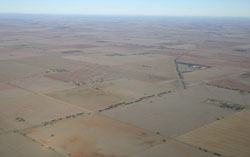 Looking south-west towards Katyil across the Kalkee plains |
3.69% of CMA region North of the Wimmera River as it emerges from the Dissected Western Uplands are the clay plains for which the Wimmera region is renowned. The Kalkee plains are synonymous with the self-mulching grey clays that have supported cereal cropping for much of the last century. These clay plains (Kalkee plains) have been divided into two units with this unit comprising a significant proportion of the traditional Kalkee clay located north of Horsham. These clay soils are found mainly in a significant band running east-west north of Horsham before calcareous equivalents dominate further north. Landform components include very gentle rises and plains with drainage across these plains very subtle and often poorly defined. The self-mulching Vertosols have high clay contents that can be variable due to micro relief and presence of gilgai. Today these gilgai are very inconspicuous owing to continued cropping of these soils and levelling of many paddocks. Soils may also be susceptible to inundation and periodic waterlogging during significant rainfall events due to high clay contents when already saturated. The dominant remnant vegetation community is Plains Savannah. Other vegetation communities present include Low Rises Woodland, Ridged Plains Mallee, Plains Grassland and Plains Woodland. | 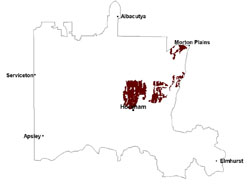 |
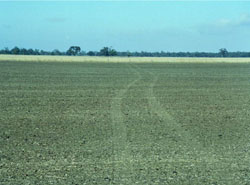 Self-mulching soils within prior stream floodplains | 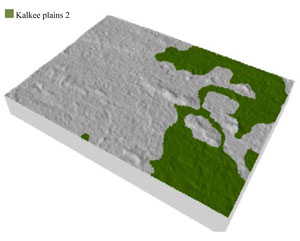 |
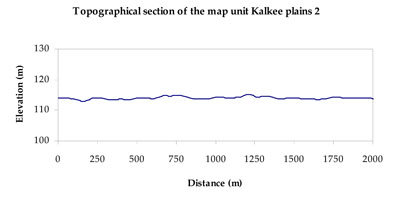 | 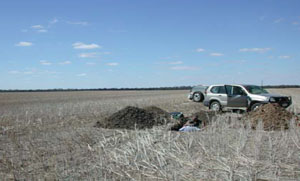 Kalkee plains near Kewell |
Component | 1 | 2 | 3 | 4 |
Proportion of soil-landform unit | 15% | 25% | 55% | 5% |
| CLIMATE Rainfall (mm) | Annual: 425 | |||
| Temperature (oC) | Minimum 8, Maximum 21 | |||
| Precipitation less than potential evapotranspiration | September–April | |||
| GEOLOGY Age and lithology | Quaternary paludal silt and clay; Neogene marine sand and silt (Parilla Sand) | |||
| Geomorphology | ||||
| LANDUSE | Uncleared areas: nature conservation Cleared areas: dryland cropping; sheep grazing | |||
| TOPOGRAPHY Landscape | Gently undulating plains (Kalkee plains) | |||
| Elevation range (m) | 100–150 | |||
| Local relief (m) | 2 | |||
| Drainage pattern | Dendritic | |||
| Drainage density (km/km2) | 0.4 | |||
| Landform | Very gentle rises | Plains | ||
| Landform element | Broad rise crest | Rise slope (low) | Plain | Swamp |
| Slope and range (%) | 2 (1-7) | 4 (3-10) | 2 (1-8) | 0 (0-1) |
| Slope shape | Convex | Convex | Concave | Concave |
| NATIVE VEGETATION Ecological Vegetation Class | Plains Savannah (38.5%), Plains Grassland (17.6%), Plains Woodland (13.3%), Other (6.3%) | |||
| SOIL Parent material | Aeolian sand and silt | Marine sand and silt | Marine sand and silt, and paludal silt and clay | Marine sand and silt, and paludal silt and clay |
| Description (Corangamite Soil Group) | Cracking clay soils (34) and sodic red texture contrast soils (39) | Cracking clay soils (34) | Cracking clay soils (34) | |
| Soil type sites | ||||
| Surface texture | Sandy loam - medium clay | Medium clay | Medium clay | Light clay |
| Permeability | Moderate | Moderate | Moderate | Slow |
| Depth (m) | 1.5 | > 3 | > 3 | > 3 |
| LAND CHARACTERISTICS, POTENTIAL AND LIMITATIONS Critical land features, processes, forms | Hardsetting upper soil susceptible to sheet and rill erosion along with wind erosion when exposed. High clay surfaces result in restricted soil drainage, but can be variable due to micro relief (gilgai).Dispersive and deep subsoils susceptible to gully erosion on steeper slopes. Compaction of upper soil variable depending on soil depth and moisture content. Upper soil is susceptible to acidification. | High clay content results in restricted soil drainage, but can be variable due to micro relief (gilgai). Soils may be susceptible to inundation and waterlogging. Surface soils are friable and only slightly susceptible to wind erosion due to self-mulching and massive nature. Soils may be susceptible at critical moisture contents and have variable resilience to compaction. | High clay content results in restricted soil drainage, but can be variable due to micro relief (gilgai). Soils may be susceptible to inundation and waterlogging. Surface soils are friable and only slightly susceptible to wind erosion due to self-mulching and massive nature. Soils may be susceptible at critical moisture contents and have variable resilience to compaction. | Susceptible to seasonal inundation, waterlogging and ultimately soil salinity. Upper soils susceptible to sheet erosion and wind erosion when exposed. |


